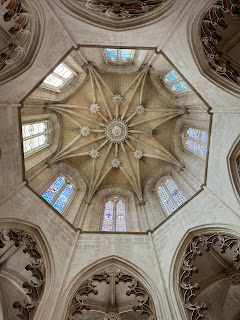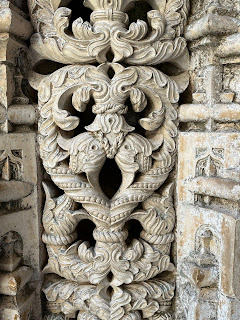We spent several days exploring the middle of Portugal for its historical villages and their sights which are spectacular.
Baltalha
The site of perhaps the most decisive battle establishing Portugal as a nation, the grateful Joao, now King Joao I, ordered a monastery to be built there. The name of the town Batalha means Battle in Portuguese. The English were invaluable allies in this battle against the Castilians (in 1385), and Joao was "encouraged" to marry the English king's granddaughter Philippa as a thank you. Not keen at first, he made the best decision not only of his life but for the future of his country. Phillipa was a remarkable, wise and capable woman (educated by Chaucer no less!). She oversaw domestic policy and boosted international trade and spearheaded the invasion of Ceuta that launched the Age of Discovery.
No wonder Joao became so happy in his marriage. He he ordered their two (elaborate) tombs to be built together in a separate space known as the Founder's Chapel in the cathedral. Their effigies even hold hands!
 |
| Philippa's right hand crossed over her body to hold Joao's right hand, as his left holds a sword |
All their children are buried around them, and in this one room one can see the reason Portugal became the most powerful and influential country in the world for generations. In birth order, we have Henry the Navigator (it was his mother Philippa who set him on this path), Fernando, a warrior, Pedro, an intrepid traveler and regent king until nephew Alfonso became of age.
The architecture of the Batalha monastery is the best gothic structure in the country - surely one of the best in the world. Unadorned by paintings and gold, it is graceful. but not without adornment of a high gothic kind, with lots of carved gargoles and pinacles and buttresses. One's eyes are drawn up and up, surely the intention as man contemplates heaven. Stained glass windows deflect light in otherworldly colour. It's a beautiful, beautiful place.
 |
| the average architect would never attempt this space - 20 metres of self-supporting stone ceiling that survived the 1755 earthquake |
 |
| imagining Philippa here, even though it was a monastery and she would never have been here, oh well, it is still a romantic cloitser |
It is more austere, but contains the bones of the tragic romantic pair of Ines and Pedro (early post)
 |
| where readings were made to eating monks |
 |
| where Cistercian monks ate (and did everything else) in silence. Just as well, the echoes in that place are deafening |
 |
| the most impressive tiled kitchen with chimneys that allowed cooked 7 whole cows to be roasted at one time |
 |
| an early two-tiered cloister |
Alcobaca also as a romantic ruined castle on the top of a hill, and a lovely town with little squares. The country's top bakery is here - it has won awards year after year for their innovative versions of the pastel de nata (custard tart) , all variations on the alchemy of eggs, sugar, pastry and almonds.
Coimbra
Did I say that you need good knees to visit Portugal? Well, I will say it here. You need good knees to visit Portugal.
This is particularly true if you want to visit the University of Coimbra, Portugal's oldest university (founded 1290) and still its most prestigious. Some of the cobbled roads are 45 degrees steep. But it was worth it. The library was stunning, like something you'd see in a movie. Three rooms leading to each other, one painted in dark red and god, one in dark green and gold, and one in black and gold - Portugal's colours. Built in two tiers, their are hidden doors and delicate ladders that allow access to the books, which are still used, although no doubt there are other libraries housing more modern tests, as well as digital libraries.
 |
| no photos allowed, so I got this off the internet |
We also saw the rooms where the higher degrees' theses are examined and defended, where science entered the realm of serious study, and where Portugal's erstwhile dictator Salazar built fascist buildings that add to the girth of the place if not its splendour. One of our favourite spots was the lovely botanical garden.
Long, long before the university, Coimbra was a good-sized Roman city, built when Christ was still alive, in about 20 AD. Its forum is now a museum of Roman history and also wonderful paintings and other treasures from Portugal's golden age.
 |
| chapel with organ that seems way too big for the space |
 |
| where you can defend your thesis if you are not too distracted by the room itself |
 |
| under the old roman forum |
On the main street there were teams of students, cloaked in their black capes, chanting slogans from their houses, and performing for beer money. Some were extremely talented and cohesive. Some sounded like a motley collection of boy who had already enjoyed sufficient beer. Later this month, when they graduate, they burn their ribbons in a colourful display that's coem down the ages. The ribbons were originally used to tie their books, so burning the ribbons symbolically indicated they didn't need their books anymore. Now of course, everything is digital, but the ritual is charming.
 |
| one of the older buildings in Coimbra |
 |
| stunning gold alter |
 |
| the most talented and polished group of students busking for beer money |
















No comments:
Post a Comment